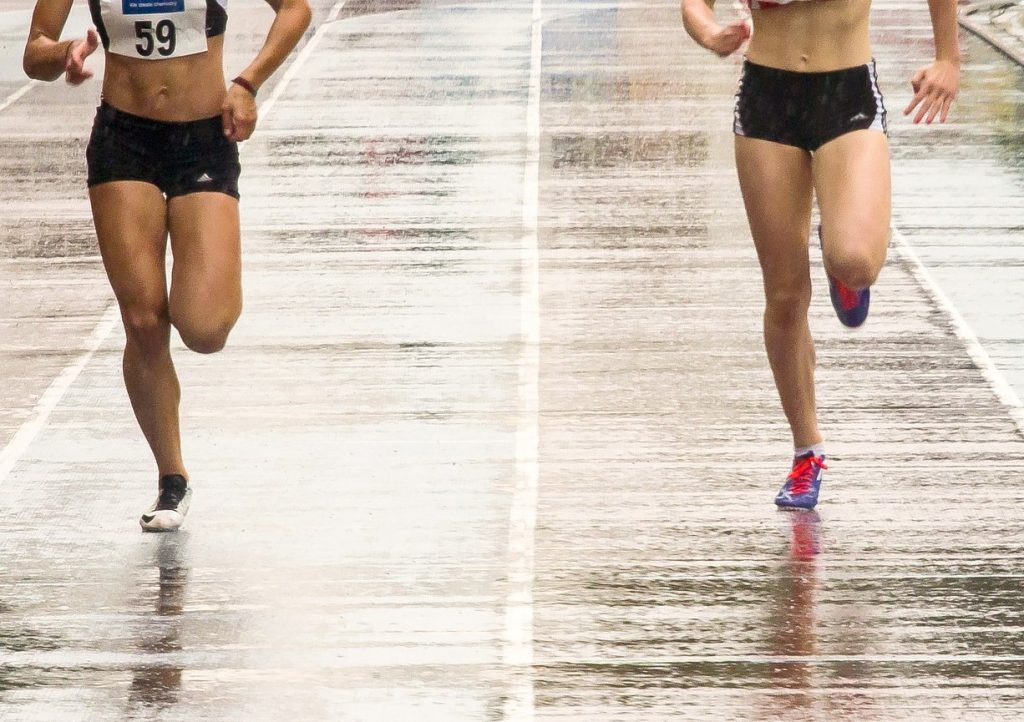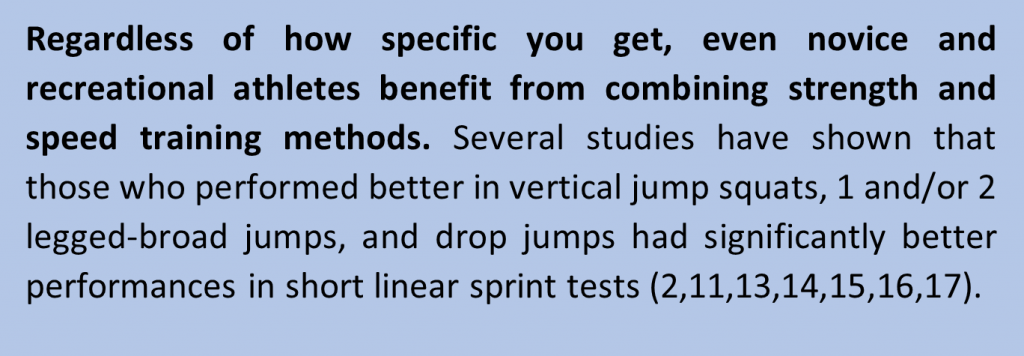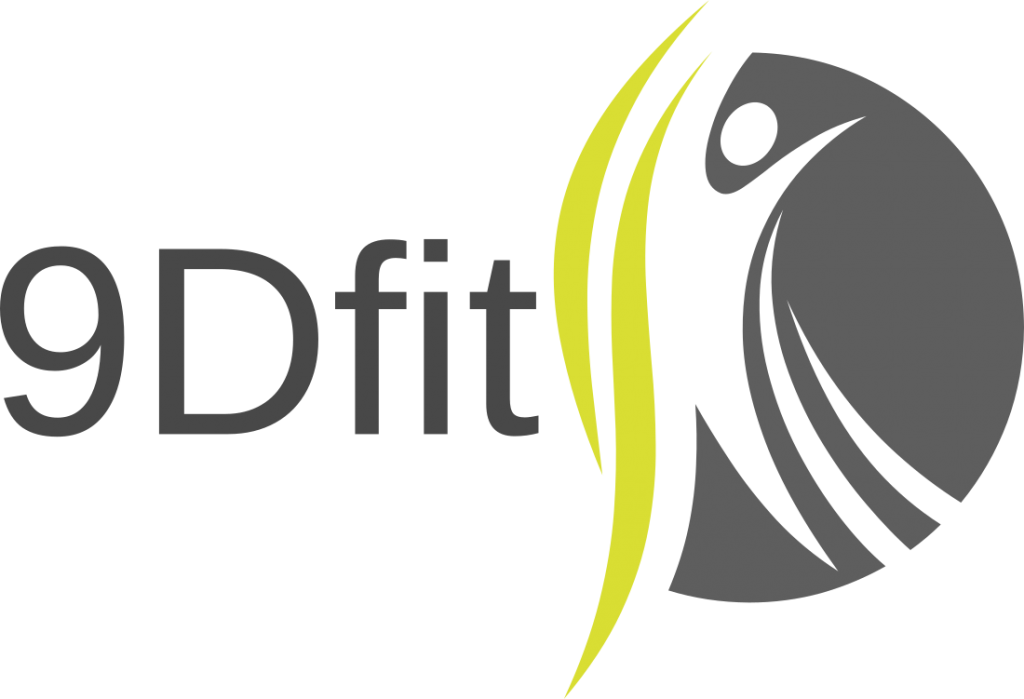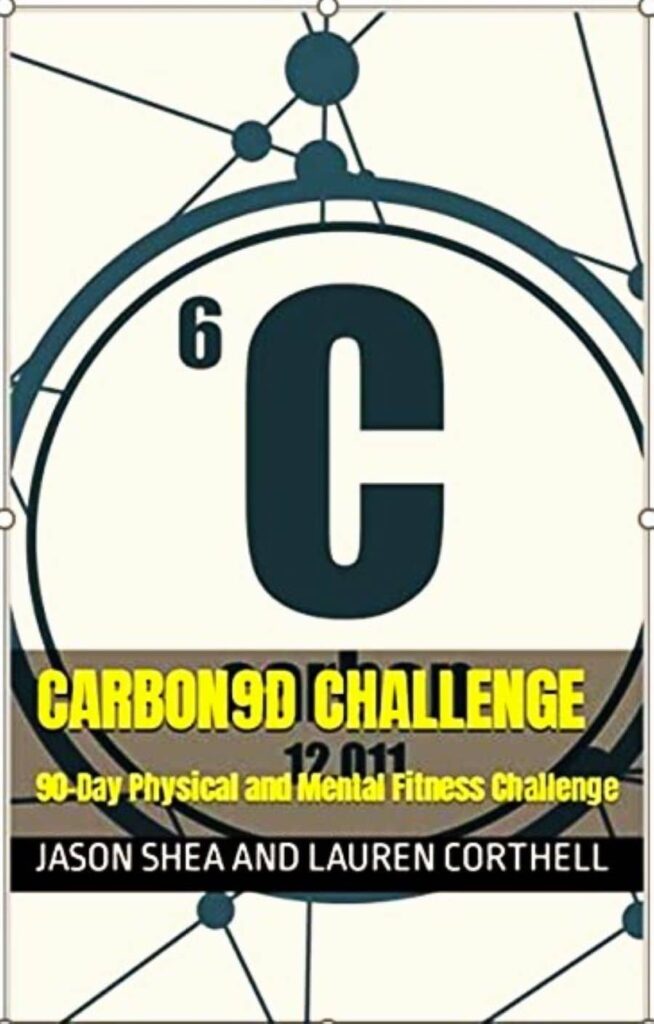By Farren Davis, MBA, CSCS,*D,RSCC and Jason Shea
What is explosive strength in sport
As athletes or parents of athletes, how often have you asked this question: What are the best exercises to improve speed?
As coaches, how many times have you been asked for an explosive strength workout program?

It is safe to say that there is no definitive singular explosive exercise or explosive athlete workout program. Every athlete is different. Every day is a different day. Every athlete has different needs based on structural imbalances, elastic (springy) vs force dominant, neurotransmitter and muscle fiber dominance, daily nervous system readiness and recovery, sleep, nutrition, stress levels, and more.
For this reason the answer may be: the exercise prescription that best addresses the individual athlete’ s physical and mental readiness on that given day, under the umbrella goal of improving their performance based on their goals and physical needs analysis of their position and sport.
Working backwards
How do athletes become more explosive?
Here is a quick hint: The athletes who can either jump the highest in the vertical jump or the furthest in the standing broad jump, are often the best performers in acceleration and explosive speed tests.

A closer look at elite high school and college athletes reveals that oftentimes the ones with the best pound for pound front squat (displaying relative strength to bodyweight) and power clean (or high pull) were nearly always the best performers in the 5-10-5 / pro-agility test.
A common theme between these athletic abilities is the displacement and redirecting of forces and loads beyond the athlete’s bodyweight… Jumping high requires forces multiple times your bodyweight driving into the ground to project the body in space against gravity, either vertically or horizontally across the ground. That ability can be enhanced through appropriate squatting and Olympic lift variations supplemented with a contrasting effect using jumping, rapid plyometrics, and more complex agility drills.
Using specific strength training movements and jump variations that mimic sport activity is an effective method for improving the speed and power of sports movements. A 2015 study on professional league Rugby players found that dominant leg lateral jump performance was a major predictor in change of direction tests (9).

Correlations between Specific Sprints and Jumps?
A 2016 study on Division I college soccer players found significant relationships between specific jump tests and sprint distances (13):
- 0–5 m sprint:
- Strong relationship with Vertical Jump, Unilateral and Bilateral Standing Broad Jump, and the left-leg Triple Hop test.
- Significant relationship with the right-leg Triple Hop.
- 0–10 m sprint:
- Strong relationship between both left- and right-leg Standing Broad Jump
- Stronger relationship with Vertical Jump, Standing Broad Jump, and left-leg Triple Hop.
- Near-perfect relationship with right-leg Triple Hop.
- 0–30 m sprint:
- Strong relationship between both left- and right-leg Standing Broad Jump
- Stronger relationship between Vertical Jump, Standing Broad Jump, and both Left and Right Leg Triple Hop. were documented with VJ, SBJ and left- and right-leg TH.
A more recent study tested 12 college basketball players in the vertical jump, standing broad jump, and 2-step approach jump while measuring average and peak power of each. The researchers then compared the results of these tests to a series of on-court sprint tests including 10 meter and ¾ court sprints, yo-yo intermittent recovery test, and pro-agility test.
They found a strong correlation between approach jump and pro-agility as well as ¾-court sprint performances, while the vertical, broad jump, and peak power correlated with 10 meter sprint performance (7).
The Importance of Bar Speed
What is Velocity Based Training (VBT)? VBT is a method of speed and strength training utilizing special equipment to monitor and track the speed in which an exercise is performed (usually recorded in meters per second(m/s)). Leading us to an easy answer to the timeless question of which exercises improve speed – the short answer is all of them will improve a specific type of speed, the type of speed and the movement trained will dictate the extent to which the training will transfer to sport performance.
When receiving feedback on the speed of each rep, you can find out exactly which area of the speed and strength continuum you are training in, and adjust your performance expectations from there.
This type of training can specifically target the performance adaptation an athlete may need to train to, general recommendations look like this:
| % of 1RM | 10-25% | 30-45% | 50-65% | 70-85% | 90-100% |
| Performance Adaptation | Starting / ”twitch” strength | Speed-strength | Strength-Speed | Accelerative Strength | Absolute Strength |
| Velocity Range | >1.3 m/s | 1.3 – 1 m/s | 1 – .75 m/s | .75 – .5 m/s | <.5 m/s |
Contrast Training
Contrast training is a method of strength training when an athlete will use a strength-based exercise paired with a more explosive movement like a jump or sprint.
Some variation of the squat movement is common practice in strength and conditioning programs, being a fundamental movement for general strength development most people can reap benefits in athletic from simply maintaining and improving their ability to perform all the variations of a squat. For further application or a squat to specific training needs, such as cutting, jumping or sprinting, this squat should be used as a primer in order to activate the body’s ability to control forces while the 2nd exercise in the circuit would be used to rapidly applying these forces.
When doing contrast sets, we want to develop strength and then speed in a similar movement pattern to support a specific goal, maybe a dunking a basketball, reaching a 40” vertical jump, or out running a defender to score a touchdown.
Training for Explosive strength using, both, VBT and Contrast-training methods – 2x/ week:
Example Circuit for Day 1:
| Exercise | Sets x Reps | Tempo / Speed / Notes | Rest |
| A1 – Snatch Grip BB High Pull | 4-6 x 2-3 | FAST (>1.2 m/s) | <30s |
| A2 – Broad Jump | 3-5 x 5 | For distance | <30s |
| A3 – T Spine Mobility | 3 x 60s ea | Breathe | <180s |
Example Circuit for Day 2
| Exercise | Sets x Reps | Tempo / Speed / Notes | Rest |
| A1 – Front Squat | 3-5 x 5,4,3,2,1 | @31X0 (>1 m/s) | <30s |
| A2 – Box Jump Variation | 3-5 x 3-5 | Fast for Height | <30s |
| A3 – Hip flexor stretch | 3 x 60s ea | Breathe | <180s |
Front Squat vs Back Squat

A 2015 study looked at the EMG activity differences of front and back squat using heavy loads. On two separate testing sessions, one for front and one for back, the subjects worked their way up to their one rep max while the researchers tested which muscles are most active in both squats. Here is what they found (22):
- The Rectus Femoris was roughly 25% more active in the front squat.
- The Vastus Medialis was 13.5% more active in the front squat.
- The Vastus Lateralis was roughly 8% more active in the front squat.
- The Erector Spinae was nearly 7% more active in the front squat.
- The Glute Max was roughly the same in both squats.
- The Biceps Femoris was roughly 8% more active in the back squat.
- The Semitendinosus was nearly 35% more active in the back squat.
Interestingly, the study (22) also looked at the muscle activity during both the concentric and eccentric phases of the max rep for each squat. Below are a few of the more significant findings:
- The Vastus Medialis was nearly 11% more active during the concentric phase vs the eccentric phase of the front squat.
- The Vastus Lateralis was roughly 17% more active during the concentric phase vs eccentric phase of the front squat.
- The Gluteus Maximus was 64.24% more active during the concentric phase vs eccentric phase of the back squat. The Gluteus Max was also 55% more active during the concentric phase of the front squat as well.
- The Biceps Femoris was nearly 87% more active in the concentric phase vs eccentric phase of the back squat. It was also nearly 50% more active in the concentric phase vs eccentric phase of the front squat.
- Lastly, the Semitendinosus was roughly 93% more active in the concentric phase vs eccentric phase of the back squat (22).
From looking at the study results, as well as the results of a 2008 study from the Journal of Strength and Conditioning Research, front squats may be more impactful on change of direction, while back squats may be more impactful for linear speed and acceleration. The study looked at the correlation between front squat, power clean, linear speed, and change of direction. The researchers found that the athletes who front squatted (avg 230lbs vs 212lbs) and power cleaned (avg 176lbs vs 154lbs) more, performed better in the 5-5 change of direction.
Squat Depth
Hartmann H, Wirth K, Klusemann M. Analysis of the load on the knee joint and vertebral column with changes in depth and weight load. Journal of Sports Medicine. 43; Pp 993-1008. 2013.
Questions answered by the above meta-analysis:
Why squats to parallel can be bad for the knees: “Based on biomechanical calculations and measurements of cadaver knee joints, the highest retropatellar compressive forces and greatest compressive stresses are observed at 90 degrees”. In other words, if you stop the lowering phase and transition to the concentric phase at 90-degree knee bend, you are exposing your knees to the greatest compressive stresses (10)”
Why deep squats are good for the knees: “With increasing flexion, the additional contact between the quadriceps tendon and the intercondylar notch as the tendofemoral support surface (wrapping effect) contribute to an enhanced load distribution and enhanced force transfer. Because lower weights are used in the deep back squat and regular strength training practice leads to functional adaptations of passive tissue, concerns about degenerative changes of the tendofemoral complex are unfounded and unproven (10).”
Why squats to parallel can be bad for women: “Women need to be particularly careful during half and parallel squat as female cadaver knees have been shown to possess 33% lower contact areas of the patellofemoral joint than male samples at 120 and 90-degree knee flexion (10).”
More why parallel squats can be bad for the knees: “The execution of a half squat cannot be recommended because the turning point is initiated in a knee joint angle amplitude, where the highest patellofemoral compressive forces and greatest compressive stresses occur with only a minor tendofemoral support surface (10).”
Why parallel squats can be bad for the low back: “The restriction of the forward knee placement will result in changes to the knee hip coordination with greater forward leaning and ventral flexion of the thoracic and lumbar spine. This evasive movement elicits greater anterior shear forces on intervertebral discs and causes tensile forces on intervertebral ligaments. For that reason, instructions about a restriction of the forward knee displacement must be strictly avoided. This recommendation is based on a misinterpretation of existing data and should be removed in future practical literature (10).”
Why you should deep squat with a controlled eccentric tempo: “The higher the lowering speed in the descent phase, the higher the developing deceleration phase to avoid a dipping movement and hence a rising increase of tibiofemoral shear and compressive forces in the turning point of the squat. For that reason, care should be taken to complete a slow and controlled execution comprising a descent phase of 3 to 4 seconds in the deep squat corresponding to an average angular velocity in the knee joint of 46.66 and 35 degrees/sec respectively (10).”
Another reason parallel squats may be bad for women: “Females possess significant lower compressive strength of vertebral bodies because of their significantly lower end plate cross sectional area than their male counterparts. This means that the female lumbar vertebral is exposed to higher axial compressive stress than a male spine when subjected to equivalent load (10).”
And finally, why deep squats may be better for your ACL: “In the deep squat loads of 1.16- and 2.27-times body weight accounted for 11.62% and 28.9% of the tensile strength of an ACL in 16 to 35 year olds. The calculated anterior shear forces in the half squat with a load of 1.16 times bodyweight accounts for between 33.29 and 41.56%. Based on these calculations, in deep squats, neither posterior nor anterior shear forces may reach magnitudes that could harm an intact PCL or ACL (10).”

Broad Jump vs Vertical Jump
A 1987 study from the Canadian Journal of Sport Sciences looked at the different contributions of the hips, knees, and ankles in the standing broad vs vertical jump. Below are some of the findings (19):

Resisted sprinting and sled pushing
A 2018 meta-analysis of 13 studies found resisted sprint training to be an effective method for improving acceleration (1). A separate review study from the 2016 Sports Medicine journal found speed could be improved when loads of 30% body mass or less were used in resisted sprints (18).
A systematic review looked at the effect different sprint training methods had on sprint performance and found resisted sprinting to be at or near the top when it came to improving short sprints and acceleration (21).
Don’t trade your barbell in for a sled just yet, though, as a 2016 study found sets of 4-8 reps at 40-60% in the deep back squat was more effective than multiple sets of 20m resisted sprints at 12.6% BM at improving 20 and 50m sprint performance (8)
One idea might be to tap into Postactivation Potentiation and combine the two. 2019 research found squats at 80% combined with resisted sprints at 12.5% BM were more effective at improving 30m sprint, countermovement jump, and change of direction, than resisted sprinting or squatting by themselves. (17). For more on Postactivation Potentiation stay tuned for part 2 of this blog article series or pick up a copy of Explosive Athlete today.
How much resistance should I use in resisted sprints and sled pushes?
Sled Push Studies
A recent study from the Scandinavian Journal of Medicine and Science in Sports recruited 50 high school athletes to figure out which sled resistance led to better improvements in sprint and vertical jump after 8 weeks of training. They assigned the athletes to one of 4 groups: control, light resistance, moderate resistance, and heavy resistance. Light resistance led to a 25% decrease in speed, moderate a 50% decrease, and heavy a 75% decrease and tested vert, sprint, hex bar deadlift, and standing long jump.
The Light group did 22.5m per sprint for total of 270 to 405m total per workout. The Moderate group did 15m per sprint for a total of 180-270m per workout. The Heavy group did 7.5m per sprint and 90-135m total per workout. All workouts had 3 minutes of rest between sprints (4).
Here are the before and after results for vert and sprint (4):




We have seen resisted sled pushes at different loads can positively impact sprinting performance after 8 weeks of training. Now, how to determine the correct load.
Using something called Vdec, basically the decrease in maximal velocity, the same research team (but in a separate 2020 study (5)) was able to determine optimal load for 3 different strength qualities:
Speed strength = roughly 0-40%BM
Power = roughly 40-80%BM
Strength Speed = roughly 80% plus
According to the researchers “adopting the Vdec method will allow practitioners to identify different training zones during resisted sled pushing, such as speed-strength, power, and strength-speed. Matching the training zone to the athlete’s force-velocity characteristic could potentially yield better training results than simply applying the same resistive load for all athletes (5).”
Compared to the one size fits all sled push approach, this Vdec individualized resistance approach to sled pushing allows for both stronger and weaker athletes to optimize specific strength qualities.
Resisted Sprint Study
In a similar study to the sled push study, a 2019 study on Rugby and Lacrosse players used roughly the same methods to determine optimal resisted sprint loads.
The researchers found the average resistance sprint loads that corresponded to a Vdec were:
25% Vdec = 33% BM (Speed Strength)
50% Vdec = 66% BM (Power)
75% Vdec = 100% BM (Strength Speed)
The study authors viewed heavier sled pulls as horizontal resistance training, to be included and periodized throughout the overall strength and conditioning program.
As in the sled push study, the researchers found three different training zones (speed strength, power, strength speed) that can be used to optimize sled loads based on training goals throughout the season (3).
A similar study, this one from the 2018 European Journal of Applied Physiology, found a Vdec of 50% in loads ranging from 69-96% BM (6).
Putting it All together
Here is an example of a once-a-day, 3X/week strength/power training + 3 speed/accelerations sessions for an optimally recovered and physically/mentally ready (nervous system/HRV/emotional state) off-season athlete.
Monday: Olympic Lift/Lower Body
| Exercise | Reps | Sets | Tempo | Rest |
| A1: Power Clean from hang above knee | 3-5 | 5 | X0X0 | 45-60s |
| A2: Broad Jump | 2-3 | 5 | NA | 90s |
| B1: Paused Back Squat w/chains | 4-6 | 4 | 31X1 | 45-60s |
| B2: Barbell Jump Squats w/dorsiflexion in air | 2-4 | 4 | NA | 90s |
| C1: Glute Ham Raise | 4-6 | 4 | 4010 | 60s |
| C2: Alternating Leg Step Forward Lunges | 12-16 (total) | 4 | 2010 | 60s |
Tuesday: Acceleration or Hill Sprints
| Sprint Type | Reps | Rest Period |
| 15yd Sprint (use farmers carry for PAP augmentation) | 6-10 (autoregulated at 5% best time drop off) | 60s |
| 30yd Sprint | 4-10 (autoregulated at 5% best time drop off) | 90s |
| Hill Sprint (20-40yds) | 2-6 (autoregulated at 5-10% best time drop off) | 90-120s |
Wednesday: Upper Body
| Exercise | Reps | Sets | Tempo | Rest |
| A1: Push Press | 3-5 | 5 | 21X1 | 120s |
| B1: Flat Fat Grip Barbell Bench Press w/chains | 3-5 | 4 | 31X1 | 45-60s |
| B2: Kneeling Chest Pass Med Ball Throw | 3 | 4 | NA | 60s |
| B3: Weighted Chin Ups | 3-5 | 4 | 3111 | 45-60s |
| B4: Rotational Med Ball Slamdowns (w/slamball) | 4-6 | 4 | NA | 90s |
| C1: V Bar Dips | 6-8 | 3 | 3112 | 60s |
| C2: Seated Cable Rows | 6-8 | 3 | 4011 | 60s |
| C3: Fat Grip Farmer Carry | 20-40ft | 3 | NA | 90s |
Thursday: Max Linear Speed
| Sprint Type | Reps | Rest Period |
| 40yd Sprint | 4-8 (autoregulated at 5% best time drop off) | 120s |
| 60yd Sprint | 2-6 (autoregulated at 5-10% best time drop off) | 120s |
| 80yd Sprint | 1-2 | 120s |
Friday: Total Body Weights
| Exercise | Reps | Sets | Tempo | Rest |
| A1: Hex Bar Deadlift | 3-5 | 5 | 31X1 | 45-60s |
| A2: Overhead Med Ball or Kettlebell Throws | 2-4 | 5 | NA | 60s |
| B1: Incline Semi-Pronated Grip DB Bench Press | 4-6 | 4 | 3010 | 45-60s |
| B2: Jump Pushups | 2-5 | 4 | 42X1 | 60s |
| B3: Pull-Ups | 4-6 | 4 | 3010 | 45-60s |
| B4: Slamdowns | 4-5 | 4 | NA | 90s |
| C1: Seated DB External Rotator | 8-10 | 3 | 4010 | 45s |
| C2: Single Arm DB Trap-3 Lift | 8-10 | 3 | 4010 | 45s |
Saturday: Sled Pushing or Resisted Sprinting
Sled Push Option
| Sprint Type | Reps | Rest Period |
| 10yd Sled Push @ 40-60%BM | 6-10 | 90-120s |
| 20yd Sled Push @10-40%BM | 2-8 | 90-120s |
Resisted Sprint Option
| Sprint Type | Reps | Rest Period |
| 15yd Resisted Sprint @ 60-70%BM | 6-10 | 90-120s |
| 30yd Resisted Sprint @20-40%BM | 2-8 | 90-120s |
Sunday: Off
If you prefer to do all your plyo and jump training in the beginning of your leg workout prior to hitting the weights here is an example:
Monday: Olympic Lift/Lower Body
| Exercise | Reps | Sets | Tempo | Rest |
| A: Resisted Broad Jump (after last set rest 30s and perform 3-4 consecutive non-resisted broad jumps) | 1 | 5 | NA | 60s |
| B: Single Leg Resisted Broad Jump | 1/leg | 4 | NA | 30s |
| C: Resisted Power Skips (after last set rest 30s and perform 4-6 non-resisted power skips) | 4-6 | 4 | NA | 60s |
| D1: Power Clean from Hang above knee | 3-5 | 5 | X0X0 | 120s |
| E1: Paused Back Squat w/chains | 4-6 | 4 | 31X1 | 45-60s |
| F1: Glute Ham Raise | 4-6 | 4 | 4010 | 60s |
| F2: Alternating Leg Step Forward Lunges | 12-16 (total) | 4 | 2010 | 60s |
Stay tuned for part 2 of The Explosive Athlete where we will talk about the most explosive athletes and how they train. If you would like to learn much more about developing explosive athletes for sports, pick up a copy of Explosive Athlete on amazon kindle or paperback today.
Thanks for reading!
References
- Alcaraz et al. The Effectiveness of Resisted Sled Training (RST) for Sprint Performance: A Systematic Review and Meta-analysis. Sports Medicine. 48(9); Pp 2143-2165. 2018.
- Bret et al. Leg strength and stiffness as ability factors in 100 m sprint running. Journal of Sports Medicine and Physical Fitness. 42; Pp 274–281. 2002.
- Cahill et al. Sled-Pull Load–Velocity Profiling and Implications for Sprint Training Prescription in Young Male Athletes. Sports. 7, 119; doi:10.3390/sports7050119. 2019.
- Cahill et al. Influence of resisted sled-push training on the sprint force-velocity profile of male high school athletes. Scandinavian Journal of Medicine and Science in Sports. 30(3); Pp 442-449. 2020.
- Cahill et al. Sled-Push Load-Velocity Profiling and Implications for Sprint Training Prescription in Young Athletes. Journal of Strength and Conditioning Research. 2020.
- Cross et al. A comparison between the force-velocity relationships of unloaded and sled-resisted sprinting: single vs. multiple trial methods. European Journal of Applied Physiology. 118; Pp 563–571. 2018.
- Daveena S et al. Lower-Body Power Relationships to Linear Speed, Change-of-Direction Speed, and High-Intensity Running Performance in DI Collegiate Women’s Basketball Players. Journal of Human Kinetics. 68; Pp 223-232. 2019.
- de Hoyo et al. Comparative Effects of In-Season Full-Back Squat, Resisted Sprint Training, and Plyometric Training on Explosive Performance in U-19 Elite Soccer Players. Journal of Strength and Conditioning Research. 30(2); Pp 368-377. 2016.
- Delaney J.A. et al 2015. Contributing factors to change-of-direction ability in professional rugby league players. Journal of Strength and Conditioning Research. 29; Pp 2688–2696. 2015.
- Hartmann H, Wirth K, Klusemann M. Analysis of the load on the knee joint and vertebral column with changes in depth and weight load. Journal of Sports Medicine. 43; Pp 993-1008. 2013.
- Lockie et al. Factors that differentiate acceleration ability in field sport athletes. Journal of Strength and Conditioning Research. 25; Pp 2704–2714. 2011.
- Lockie et al. Relationship between unilateral jumping ability and asymmetry on multidirectional speed in team-sport athletes. Journal of Strength and Conditioning Research. 28; Pp 3557–3566. 2014.
- Lockie R, et al. Relationships and Predictive Capabilities of Jump Assessments to Soccer-Specific Field Test Performance in Division I Collegiate Players. Sports (Basel). 4(4); Pp 56. 2016.
- Loturco et al. Vertical and horizontal jump tests are strongly associated with competitive performance in 100-m dash events. Journal of Strength and Conditioning Research. 29; Pp 1966–1971. 2015.
- McCurdy et al. The relationship between kinematic determinants of jump and sprint performance in Division I women soccer players. Journal of Strength and Conditioning Research. 24; Pp 3200–3208. 2010.
- McFarland et al. Relationship of two vertical jumping tests to sprint and change of direction speed among male and female collegiate soccer players. Sports. 4 doi:10.3390/sports4010011. 2016.
- Pareja-Blanco et al. Combined Squat and Light-Load Resisted Sprint Training for Improving Athletic Performance. Journal of Strength and Conditioning Research. 2019.
- Petrakos et al. Resisted Sled Sprint Training to Improve Sprint Performance: A Systematic Review. Sports Medicine. 46(3); Pp 381-400. 2016.
- Robertson and Fleming. Kinetics of Broad and Vertical Jumping. Canadian Journal of Sport Sciences. 12(1): Pp 19-23. 1987.
- Sekulic et al. Gender-specific influences of balance, speed, and power on agility performance. Journal of Strength and Conditioning Research. 27; Pp 802–811. 2013.
- Sleivert et al. The Relationship Between Maximal Jump-Squat Power and Sprint Acceleration in Athletics. European Journal of Applied Physiology. 91(1); Pp 46-52. 2004.
- Yavuz et al. Kinematic and EMG activities during front and back squat variations in maximum loads. Journal of Sports Sciences. 33(10); Pp 1058-1066. 2015.



